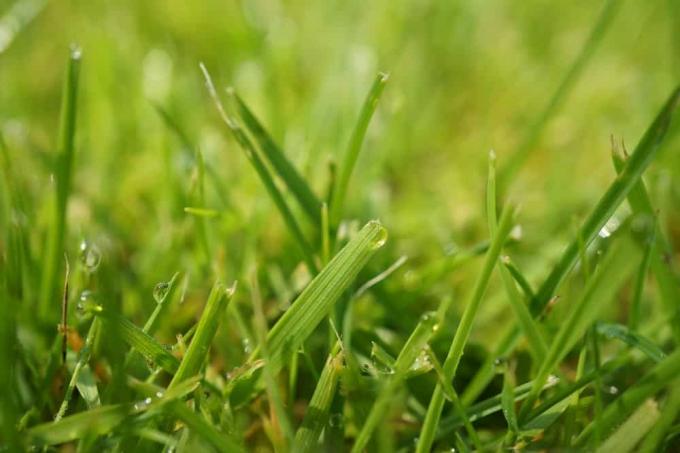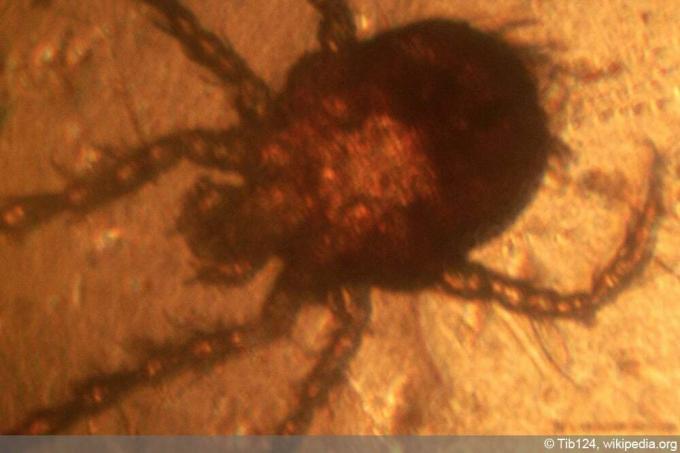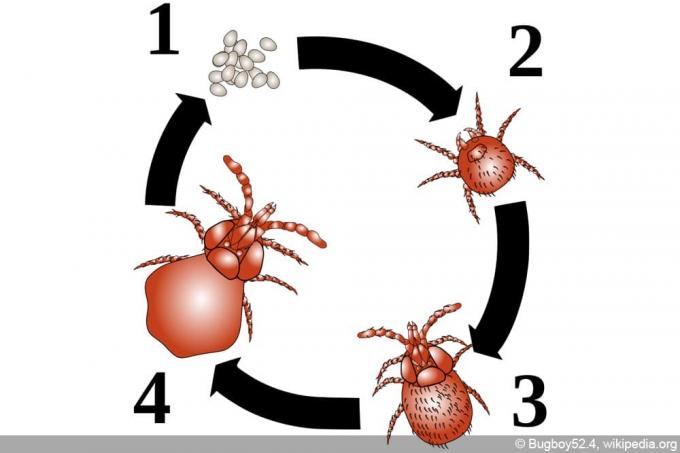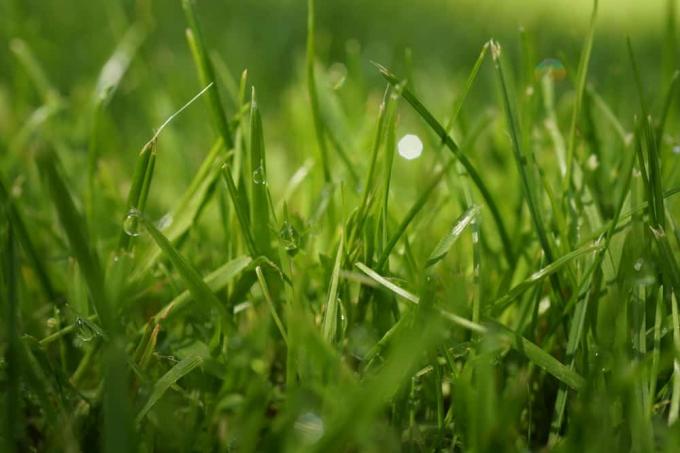

Table of contents
- Description
- Look
- contact with people
- detect bites
- symptoms
- treatment in humans
- treatment in animals
- occurrence and distribution
- life cycle
- Tracking mites in the garden
- combat
- protective measures
- Conclusion
They are tiny and yet can trigger an itch that drives many people to despair. In recent years, more and more people suffer from a strange type of insect bites, which appear in a larger number of places that are not typical for ordinary mosquito bites. In addition, these bites itch much more and often for weeks. Anyone who has been bitten by grass mites needs a lot of self-control not to constantly scratch. Here you can find out what you can do against grass mites and their bites.
Description
Grass mites belong to the species-rich family of arachnids, which also includes ticks. Many mite species are omnivores or herbivores, some are parasitic or predatory. The mite that causes severe itching in humans with its bites is the harvest mite
(Neotrombicula autumnalis), a so-called running mite. Real grass mite bites (Bryobia graminum) do not itch as much and the mite species is also significantly smaller. Harvest mites have many names in German-speaking countries.In addition to the conventional designation grass mites or hay mites, they are also known as grass lice or ground lice. The name grass flea is somewhat misleading, because the Neotrombicula autumnalis is large related to fleas, but belongs to the running mite family and not to the fleas.
While adult fall grass mites live below the surface of the soil and do not bite, their larvae are all the more aggressive. They are tiny, only 0.2 millimeters in size, but can move quite quickly. In order to be able to defend oneself against the small parasites, it is helpful to understand how the grass mite lives and how it comes into contact with humans.
Look
The adult autumn grass mite is intensely red in color and about two millimeters long. The body is flat, heavily constricted behind the shoulder and covered with dense bristles. It has eight short legs, each with two claws at the end.
The larvae of Neotrombicula autumnalis are the causative agents of what is known as trombidiosis, also popularly known as harvest scabies or gooseberry disease. These larvae have a wide oval body and are only about 0.2 millimeters long, so they are hardly visible to the naked eye. In contrast to the adult animals, they only have six legs, each with three claws at the end. Fall mite larvae are pale yellow to orange-red in color and have strong jawed claws.
contact with people
The larvae of the harvest mite live on blades of grass and other elevations of up to 20 cm above the ground ground level and wait there for passing hosts to be able to bite down and close cell juices suck. Grass flea hosts typically include small mammals such as mice, but also pets that roam the grass. Humans become victims of these larvae only through casual contact. The parasitic autumn mite larvae love low grass areas. They make little difference whether it is a natural meadow, the edge of a forest or even the lawn in your own garden. And they aren't very picky about their hosts either.
If you brush a larva off a blade of grass with your leg or foot, it will quickly run up your legs. Because despite their small size, the little animals are very mobile. Grass fleas prefer warm, humid areas on the body with thin skin. That is why they are usually found in the back of the knee, in the armpits or in the pubic area. But bite marks also appear under tight-fitting clothing, for example under stockings, belts or the elastic bands of items of laundry.
Tip:
Since pets in particular are suitable hosts for the autumn mite, symptoms such as rashes and itching can also be found in them. So pay attention to the corresponding symptoms in your dog or cat as the first warning signal for your own health.
detect bites

Once lodged in the top layer of skin, the larva of the harvest mite injects saliva containing enzymes that soften and liquefy the skin. In this way it reaches the cell juices and the lymph of the host in order to suck them up. The red spots are usually quite small, about one to three millimeters in diameter. From time to time, however, the wheals are up to one centimeter in size and resemble mosquito bites.
Typical for the grass flea, many small bites appear side by side on the skin. The animals themselves are rarely found, as the itchy wheals only appear 24 hours after a bite. Then you often don't know who is actually responsible for the stings and usually suspect completely different insects. Even doctors often reach their limits when it comes to identification, because the risk of confusion with the bites of fleas and bed bugs is high.
symptoms
After a bite, people and pets often suffer from severe itching for weeks. As a rule, these are small reddened spots that often protrude as pustule. This phenomenon is called trombidiosis in technical jargon, colloquially harvest scabies or autumn bite.
Itching usually only sets in after a day; and each person reacts very differently to the bites of the autumn grass mite. Some notice almost nothing at all, while others are itching unbearably for days. Many people react to flea bites with an allergic reaction or skin inflammation, especially if the itchy areas of skin are scratched intensely. Very sensitive people can also get a fever.
- severe itching
- Redness at the puncture site
- fluid-filled blisters
- pustules
- Wheals with a crusty surface
- secondary infections
- in rare cases fever
The skin reactions are mainly found in areas of skin folds (armpits, back of the knees) and above and below the waistline. As a rule, the same number of individual bites can be found in a small area.
Tip:
The severity of the reaction depends on many individual factors. While one family member may not have any symptoms, other family members may experience very different symptoms.
treatment in humans
Fortunately, the bites of grass fleas are not really dangerous, because the larvae do not transmit diseases such as ticks. To prevent secondary infection, it is important to disinfect the bite sites with 70% alcohol or another suitable agent. Anti-itch gels, creams or tinctures can be used to relieve the itching. Good results have also been achieved with a short shock heat treatment. It is best to use an electronic stitch healer or a heated teaspoon, which you press briefly on the appropriate spot.
- disinfect with alcohol
- Thermal shock with hot spoon or electronic stitch healer
- wet envelopes (cooling)
- Ointment or gel to relieve itching
- Home remedies such as onion juice or lemon juice
- do not scratch

With a larger number of bites, the itching can become unbearable. If it can no longer be endured or if the skin becomes inflamed, you should see a doctor early on. They can possibly prescribe you a cortisone ointment or an antihistamine and treat the inflamed skin with an antibiotic.
treatment in animals
While the larvae of the autumn grass mite in humans usually disappear after a few hours, the situation is often very different in pets. The parasites often live on animal hosts until they are fully grown. In order to spare your animal the agony and minimize the risk of infecting itself with the stubborn pests, a sophisticated control method is required.
- wash infested pets with antiparasitic shampoo
- Treat bites with alcohol or other disinfectant
- apply soothing lotion or tincture for the appropriate species
- Have inflammation treated by a veterinarian
- use a spot-on product to prevent fleas, mites and ticks (e.g. with the active ingredient fipronil)
- as a precaution, wash all blankets and bedding at high temperature
- Use perimeter spray for pet's sleeping areas and hard-to-reach places
occurrence and distribution
The autumn mite occurs from western Europe to eastern Asia. Grass fleas occur in large numbers in some places, but the distribution is usually very regionally restricted. In Germany, such thrombidiosis foci are widespread. Especially in the Stuttgart, Munich, Frankfurt and Rhineland areas, they have become a real plague in the last 10 to 15 years. In warm and sunny weather, they infest their hosts, which include small mammals, dogs, cats, birds and also humans, in parks, green areas or even house gardens. Grass fleas prefer low vegetation, which is why they are usually found on lawns, in moss or in mulched beds.
It is quite possible that you have harvest mites in your garden and your neighbor remains completely unmolested. Mite populations quickly adapt to local conditions, in this case probably their potential hosts. So if you have certain small mammals (mice, rats, rabbits, etc.) or dogs and cats living with you, your garden is particularly attractive to the parasites.
However, that does not mean that you are a victim of grass mites because of your pets or the particularly ecological gardening. An increased occurrence of these tormentors is also subject to an unexplored temporal change and is dependent on complex macro- and microclimatic conditions. Luckily, an infestation with these running mites usually doesn't last longer than about two months.
life cycle
The adult arachnids actually live in the ground and prefer very specific soil conditions. In warm, humid weather, they come close to the earth's surface. During rain and frost, they penetrate deep into the ground. Adult grass fleas are not dangerous to humans or animals because they are not parasitic. Egg laying takes place in the ground. After about four weeks, the mite larvae hatch and migrate to the surface in search of a host.
- Main occurrence: July to October (larvae)
- Depending on the weather, it can also be found as early as April
- Minimum temperatures: permanently above 10 degrees
- they are most active at temperatures around 25 degrees

They let themselves be stripped from low vegetation by their host in order to cut open the cornea with their powerful jaw claws and drink the cell juices. Depending on the host, this sucking process lasts between a few hours (humans) and several days (in smaller animals). They then drop back to the ground and develop into nymphs. After moulting and another resting stage, the adult grass flea develops, which stays in the ground and only feeds on plant material and insect eggs. Only the mobile larvae parasitize on mammals.
Tracking mites in the garden
It is very difficult to find out whether and how many harvest mites have settled in your garden. Adult mites cannot be found at all because they live under the surface of the earth all year round. Only the innumerable larvae emerge from the soil to lie in wait for a host in an exposed spot in the grass. The larvae of the grass fleas are usually only noticed when the first bites occur. And even then, few people have ever seen one of these parasites. They are so small that you don't even notice when the little creatures are walking over your skin or biting.
If you suspect that a colony of grass mites has settled in your garden, it will not help to search for them on your knees in the grass. Just put a white sheet of paper in place and wait. If masses of larvae are on the move, the leaf will take on a reddish tinge because the larvae are yellowish to orange-red in colour.
combat
A quick and effective control and eradication of grass mites is not possible. Because chemical or biological control agents that specifically kill these parasites do not exist. Fighting grass fleas therefore primarily means prevention and decimation of the population. Garden owners should try to deprive autumn grass mites of their habitat. Since the parasites prefer to stay in the lawn, it should be kept short. Nesting sites of any kind must also be removed or avoided.
- Mow the lawn very short several times a week
- Dispose of grass clippings immediately (household waste)
- Wear protective clothing (rubber boots, long pants, gloves when picking up)
- Tuck pant legs into shoes or socks
- Water the lawn daily
- Remove rodent nesting sites (in woodpiles, tool sheds, etc.)
- Move compost heap (nesting place for mice)
- Remove moss from the lawn (scarify)
- spray smaller areas with neem oil
- Fertilize the lawn with calcium cyanamide in May (mow beforehand)
protective measures

If you have already been bitten by autumn grass mites or if you have discovered a population in your garden, it is important to avoid any possible contact with the larvae. To ward off the harvest mite larvae, rubbing in a repellent that repels insects such as mosquitoes or ticks with scents can help. Spray the shoes and trouser legs with it up to the knee height. Taking vitamin B supplements is also said to drive away the parasites, since in this case the body odor changes and the larvae no longer like it.
- Do not enter meadows with a known mite infestation
- If necessary, wear rubber boots and closed clothing
- never sit or lay on the ground
- Change clothes and shower immediately after contact with infested areas
- Use repellents (deterrents) against insects and ticks (effective for about 5 hours)
- Only go out in the garden or on walks with sturdy shoes and long trousers
- Pull stockings over pant legs
- Use products containing synthetic or natural pyrethrum (an extract from a certain species of chrysanthemum).
- Take vitamin B complex (possibly discuss dosage and duration with your doctor)
Insecticides should not be used in your own home garden because of the environmental pollution and danger to humans and animals. In addition, no sufficiently effective remedy is known to combat the harvest mite.
Conclusion
The stings of harvest mites are very annoying, sometimes almost unbearable, but not dangerous for humans. The itchy rashes can be treated with antipruritic agents or preparations containing cortisone and antihistamines (from the doctor). Unfortunately, there is still no herb against the parasites themselves. Here it only helps to protect yourself well and to make it as uncomfortable as possible for the grass fleas on your own property.
 garden editorial
garden editorial I write about everything that interests me in my garden.
Learn more about pests

Ants in the raised bed: what to do?
If ants are found in the raised bed, quick action is required. With the right means and measures, however, the insects can be easily controlled or driven away.

Fight vine weevil: 6 home remedies
The vine weevil is only a problem in the garden when it occurs in large numbers. The beetle eats the leaves, the damage to the larvae is much greater. They eat at the roots and can also cause plants to die off.

Big holes in the garden: which animal was it?
Whether in the lawn or "just" in flower beds, holes in the ground make no gardener happy. But who causes the holes? And how do you get rid of them? We explain causes and strategies for annoying visitors underground.

Combat Little Red Spider | 7 tips for garden & balcony
Although the little red spider is harmless because it neither stings nor transmits diseases, its occurrence is still a thorn in the side of many people. The little creatures become particularly annoying when they are not just limited to infesting plants, but also spread out on the balcony or even in the apartment. Fortunately, effective biological measures exist to control the arachnids.

Rats in the garden: what to do? How to fight the plague of rats
Many people are disgusted just at the thought of rats: after all, the harmful rodents have been considered carriers of dangerous diseases for thousands of years. The animals also cause considerable damage in the house and in the garden. This is how you get rid of the plague again - sustainably and effectively.

Ultrasonic Rat Control – Does Ultrasound Help Against Pests?
Rats in the house or in the garden are not only disgusting, they can also quickly become a problem. But what can you do about it? Ultrasonic rat control is often recommended. However, the method is very controversial. More about this is here.



